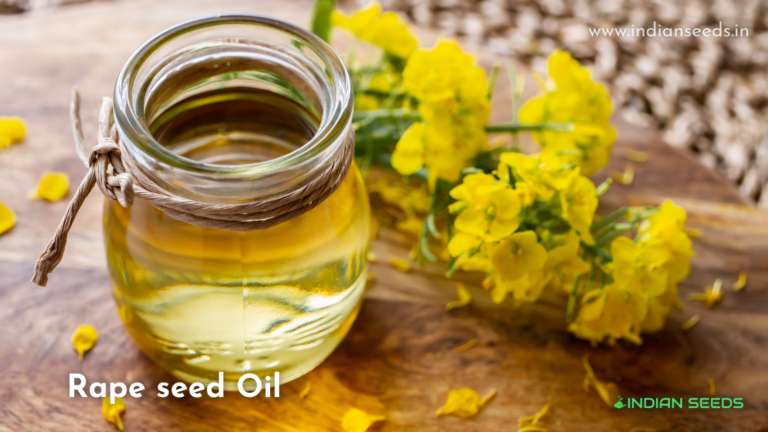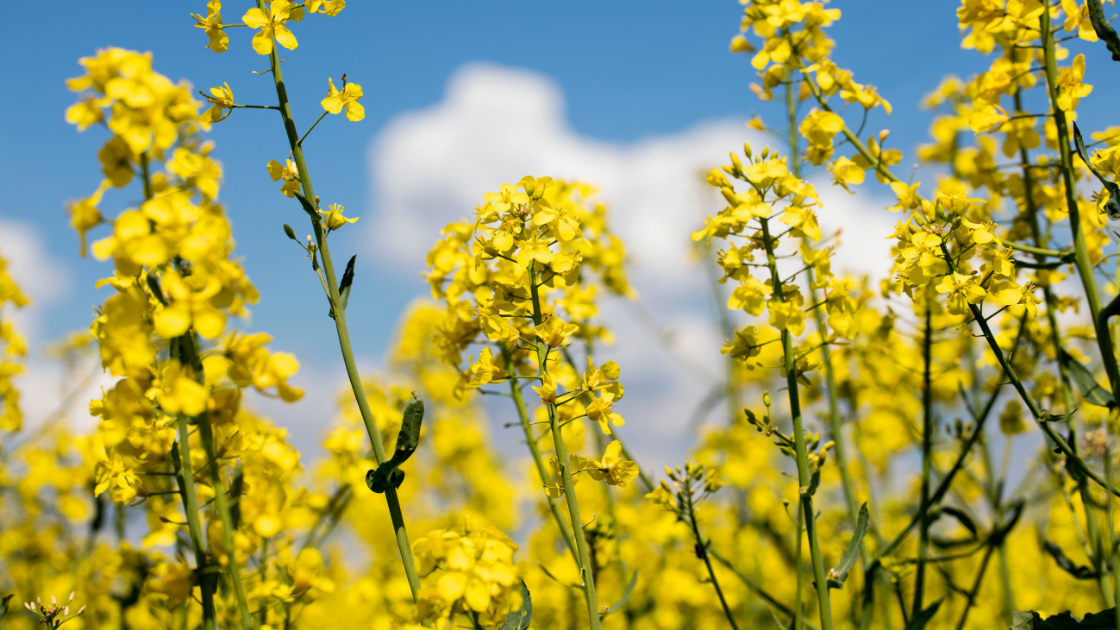Summer is when the rape seed plant blooms, and it is known for its golden-yellow flowers. It is closely related to mustard and belongs to the cabbage family.
Its oil, which goes by the names of rapeseed and canola, is widely used in cooking, baking, frying and food processing.
What is Rape Seed?
Rape seed is a huge winter or spring annual oil crop in the Brassica family that goes by the names rape, oilseed rape, and canola for a specific group of cultivars. Rape seed plants are three to five feet tall and feature four-petaled yellow flowers. Rape seed has a fibrous, near-surface root system and a deep taproot.
Common Names of Rape Seed
The word “rape” comes from the Latin word rapa or rapum, which is related to the Greek word rhapys.
Rapeseed in Hindi –
Rapeseed Plant

Rapeseed Flower

Uses or Application of Rape Seed
- Rape seed is cultivated for the production of edible vegetable oils, Animal feed and biodiesel. After soybean and palm oil, rapeseed was the world’s third-largest source of vegetable oil in 2000. After soybean, it is the world’s second-largest source of protein meal.
- Rape seed contains more than 40% oil which can be more economical in some locations than soybeans, which contain only 18% oil.
- Rape seed is also useful as a cover crop and as a source of annual fodder.
- It provides good soil cover throughout the winter to reduce soil erosion, produces a lot of biomass, suppresses weeds, and has a root structure that helps increase soil tilth.
- During the fall growth phase, cattle can graze on rapeseed.
- Traditionally, industrial rapeseed has been used to make birdseed and oil for use in industry. Rapeseed variants utilized in industrial applications include lubricants, hydraulic fluids, and polymers. Where great heat stability is required, high-erucic-acid rape seed oil is particularly useful.
- Rapeseed has potential usage in biomedical applications (lubricants for artificial joints) and as a bio lubricant.
Benefits of Rape Seed

- Healthy Cooking Oil
Rapeseed oil has a high smoke point, which means it won’t burn until it reaches roughly 200 degrees Celsius. Fat molecules begin to break down and form toxic chemicals at this temperature. This makes it excellent for high-heat cooking methods such as sautéing, pan-frying, baking, and deep-frying.
- Versatile
It’s great in salad dressings, dips, and baking, and it may also be used for pan-frying or deep-frying without adding flavour.
- No Flavour
Rapeseed oil has a moderate flavour that makes it suitable for a wide range of culinary uses. It can also be cooked or served at room temperature.
- Economical
Because of its widespread manufacturing, rapeseed oil is very economical and accessible.
Extra virgin olive oil, for example, is more expensive due to its more sensitive production procedures and shorter shelf life.
Rapeseed Cultivation Practice
Rapeseed was one of the first plants to be widely farmed by mankind, dating back over 10,000 years. Rapeseed was first grown in India about 4000 B.C., and it reached China and Japan 2000 years later.
Due to the required of vernalization to begin the flowering process, rapeseed oil is mostly grown in its winter form in most of Europe and Asia. It is sown in the autumn and survives the winter as a leaf rosette on the soil surface. The following spring, the plant develops a long vertical stem, followed by lateral branch development. It usually blooms in late spring, with pod growth and ripening taking 6–8 weeks till July.
Winter rapeseed is planted in Europe as an annual break crop in three to four-year rotations with cereals like wheat and barley, as well as break crops like peas and beans. This is done to limit the risk of pests and diseases spreading from one crop to the next.

The crop is planted in the spring, and stem development occurs shortly after germination.
Rapeseed may be grown in a wide range of well-drained soils, favours a pH of 5.5 to 8.3, and has a moderate salinity tolerance.
It is primarily a wind-pollinated plant, but when bee-pollinated, it produces much higher grain yields, approximately doubling the ultimate yield[26], however the effect is cultivar-dependent. [36] It is currently farmed with a lot of nitrogen-based fertilisers, and the manufacturing of these fertilisers produces N2O. Approximately 3-5 percent of nitrogen applied to rapeseed as fertiliser is transformed to N2O.
FAQs on Rape Seed
What is the difference between Mustard Oil and Rape Seed Oil?
Mustard and Canola plants are well-known vegetables from which mustard and rapeseed oils are extracted. Both of these plants are members of the Brassica family, with mustardseeds coming from Brassica juncea and rapeseeds (canola) coming from Brassica rapus.
Waht is the difference between Canola Oil and Rapeseed Oil?
The names “rapeseed” and “canola” are occasionally used interchangeably. Rapeseed is the traditional term for the Brassicaceae family of oilseed crops. It is classified as either ‘commercial rapeseed’ or ‘canola’. The seeds of the two varieties are visually identical. The chemical or fatty acid profiles of the two varieties are the distinguishing feature between them.
In general, “commercial rapeseed” refers to any rapeseed with a high erucic acid content in the oil (at least 45 percent). The word ‘Canola’ was first registered in Canada in 1979 and refers to an edible oil crop with low amounts of erucic acid (below 2%) and glucosinolates. The focus of this profile will be on industrial rapeseed.
From where the name 'Rape Seed Oil' came from?
Because it’s made from the seeds of the rapeseed plant. Dictionary.com defines it as follows: Middle English, from Middle French or directly from Latin rpum (neuter), rpa (feminine) “turnip,” first recorded in 1350–1400; cognate with Greek rhápys.
What is Canola Oil?
Rape seed oil is all the same. Rape is a mustard-like plant. The issue with rape seed is that the rape plant contains a couple of poisonous mustard compounds, but plant breeders in Canada developed a much less toxic type of rape approximately 30 years ago. It was given the name Canola. Huge fields of vivid yellow flowers, rape fields that seem like fields of yellow mustard, will be visible today.



















